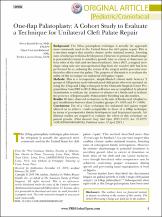One-flap palatoplasty: A cohort study to evaluate a technique for unilateral cleft palate repair

Ver/
Descargar
(application/pdf: 1000.Kb)
(application/pdf: 1000.Kb)
Fecha
2015-04Autor(es)
Rossell-Perry, Percy
Cotrinal-Rabanal, Omar
Caceres-Nano, Evelyn
Metadatos
Mostrar el registro completo del ítemResumen
Background:
The 2-flap palatoplasty technique is actually the approach most commonly used in the United States for cleft palate repair. This is a one-time surgery that enables closure under minimal tension, lowering rates of subsequent fistula development. However, its primary disadvantage is potential detriment to maxillary growth (due to extent of dissection on both sides of the cleft and raw lateral surfaces). Since 2007, a surgical technique using only one mucoperiosteal flap from the noncleft side has been performed by us, reducing the extent of the surgery and its potential nondesirable effects over the palate. The purpose of this study is to evaluate the utility of this technique for unilateral cleft palate repair.
Methods:
This is a retrospective, simple-blinded cohort study between 2 groups of 120 patients each with unilateral cleft palate who were operated on using the 2-flap and 1-flap techniques by the Outreach Surgical Center Program Lima from 2007 to 2012. Data collection was accomplished by physical examination to evaluate the presence or absence of a fistula and to evaluate the presence of hypernasality. Postoperative bleeding was also studied.
Results:
We have observed no increase in the rate of fistulas and velopharyngeal insufficiency between these 2 studied groups (P = 0.801 and P = 1.000).
Conclusions:
Use of a 1-flap technique for unilateral cleft palate repair allowed us to achieve results comparable to those of a 2-flap technique in terms of postoperative fistula development and hypernasal speech. Additional studies are required to evaluate the effect of this technique on palatal growth.
Colecciones
- Artículos [274]







